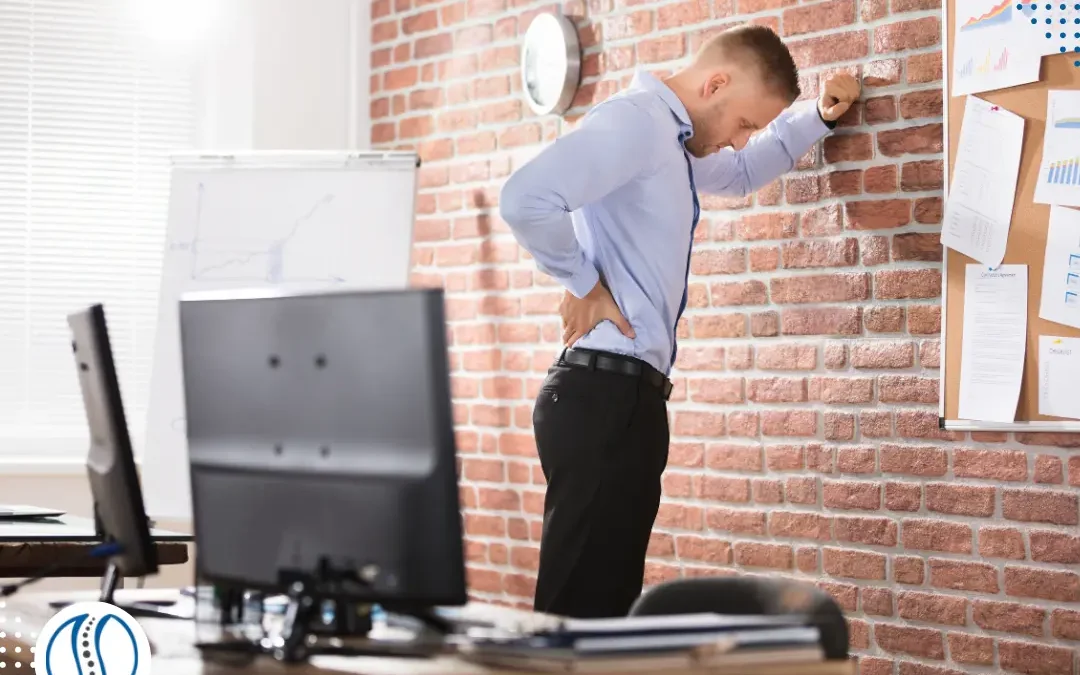Have Back Pain? Change Your Workstation Ergonomics ASAP!
The most common complaint of back pain for office workers is a general non-specific back ache that is caused by poor workstation ergonomics – or more simply stated – poor posture when sitting for prolonged periods.
But what exactly is workstation ergonomics?
Workstation Ergonomics is the interaction between you and your tools. Wouldn’t it be nice if you could adjust your desk, computer monitor, and chair to eliminate back and neck pain and improve productivity? Well, you can. That’s what workstation ergonomics is all about.
You see your workstation position (which includes the height, distance, and tilt angles of your desk, computer monitor, and/or chair) all affect your postural alignment.
There are two main groups of back issues that can be attributed to poor office ergonomics:
The first are those issues that can be traced back to actually being caused by prolonged sitting or poor office ergonomics. In other words, the injury was actually caused by the seated posture or poor office ergonomics.
The second issue is when office ergonomics may not be the initial cause of the injury or pain, but it is making the injury worse or inhibiting recovery.
Causes of Ergonomic Back Injuries
The majority of ergonomic back injuries are caused by the accumulation of small stresses. Over time, these stresses accumulate into larger stresses, until the body is unable to recover at the same rate that the stresses accumulate. This then leads to an injury developing.
It is called a non-specific ache because it is non-specific in the sense that there isn’t one particular part of the back (i.e. disk, ligaments, joints, muscles) that is causing the symptoms. Instead, the pain is probably coming from a combination of areas that are all being stressed by the problematic posture.
Preventing Ergonomic Back Injuries
Move!
With this in mind, the number one way to prevent ergonomic back injuries from occurring is to avoid prolonged sitting. If you have a standing desk available, it is recommended to switch between sitting and standing regularly throughout the day.
Further, get in the habit of getting up from your desk regularly, to break up the monotony of sitting. Some ideas to do this include:
- Instead of emailing or calling colleagues, walk to their office.
- Drink lots of water so you have to go to the bathroom more often.
- Habitually work off a 25/5 principle. This means you work hard for 25 minutes, with no distractions, with your focus entirely on the task at hand. Then have a 5 minute break whereby you physically get up from your desk and move around.
- Have some exercise posters placed around your desk or the office to remind you to get up regularly and do some of the stretches.
- Set a timer to remind you to stretch and move.
You’ll be amazed at how something as simple as a deep breathing or pushing yourself away from your desk for several minutes can rejuvenate you.
Adjust Your Workstation
Make sure your office chair:
- Has a good backrest that provides lumbar support.
- Can recline (sitting upright at a 90º angle is actually not good for your spine, 100º-110º is better).
- Is not too high (your feet should be flat on the floor OR resting on a stool).
- Can rotate or swivel so that you can easily switch from task to task.
Sit in the chair facing forward with perfect posture. Then adjust your desk around that.
While seated in that perfect position, construct the work environment around that position. In other words, all other pieces of furniture and equipment must be positioned to accommodate that perfect position. It might require stacking several books under the computer screen to bring it even to head level. The screen must be at eye level and the user should sit directly in front of the screen. A sliding keyboard attachment under the desk might be beneficial.
Since most office work is done on computers, where your equipment is placed can make a difference in how your back feels when you are at work. Try the following:
- Tilt the keyboard down and slightly away from you for better wrist posture.
- Make sure your mouse is close enough so that you can use it with your arms relaxed and as close to your body as possible.
- Place the monitor directly in front of you at eye level, not off to one side, to avoid neck and eye strain.
- If using a laptop, consider getting an external monitor or keyboard (or both). This will allow you to move each of these components separately to create a comfortable arrangement.
Finally, take a (spine) break!
Not just a coffee break, but a spine break. Stretch! Take a short walk and get the blood flowing. When you are at your desk, avoid staying in one position for a long time. Try switching between sitting and standing.
Wouldn’t it be great to be able to leave your office feeling as refreshed as when you came in? Avoiding excessive strain on your spine can help you do just that.




